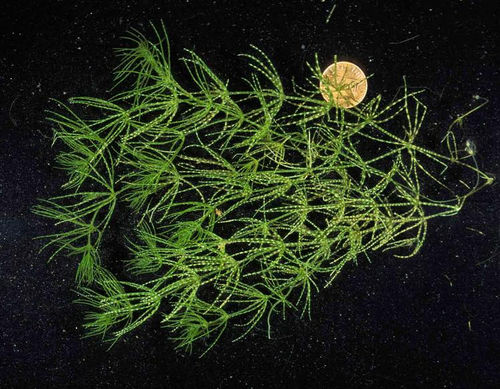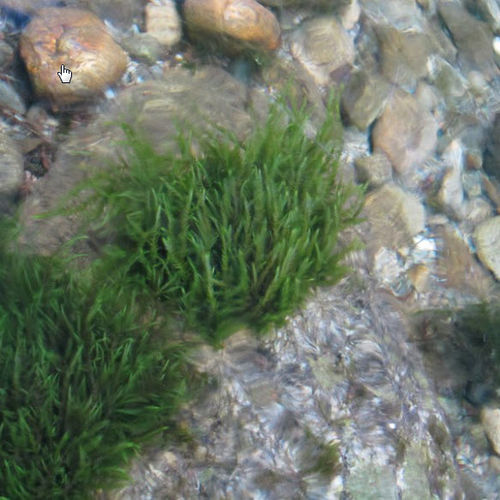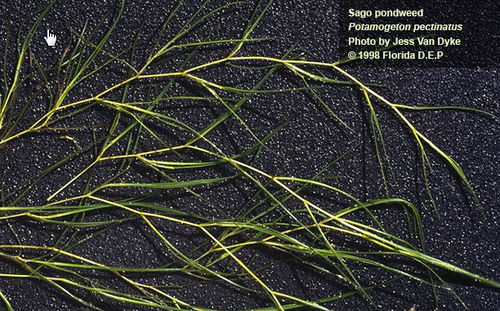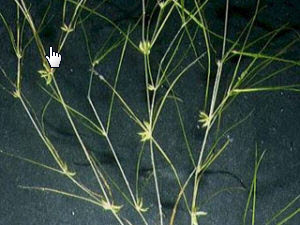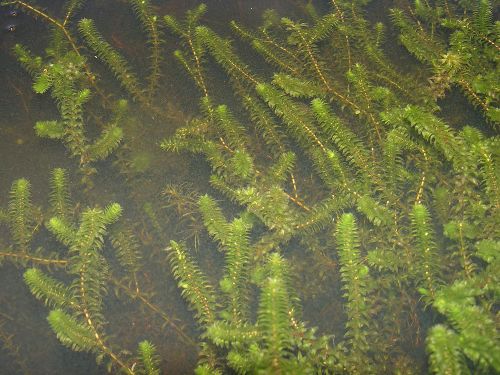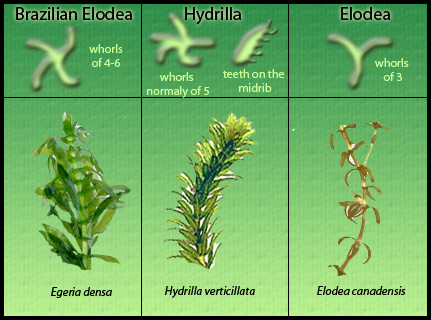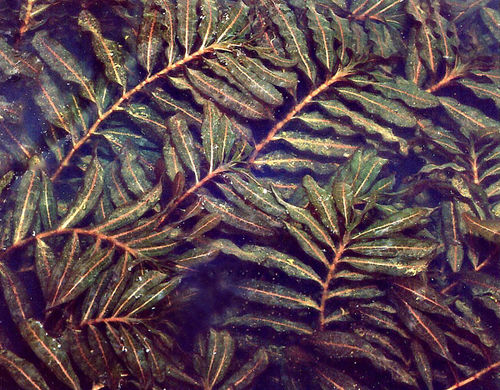Difference between revisions of "Algae and Aquatic Macrophytes"
Cellsworth (Talk | contribs) |
Cellsworth (Talk | contribs) |
||
| (10 intermediate revisions by the same user not shown) | |||
| Line 17: | Line 17: | ||
</table> | </table> | ||
| − | + | [[File:cladophora.jpg|thumb|center|500px|Cladophora, a filamentous green algae]] | |
<!-- | <!-- | ||
| Line 23: | Line 23: | ||
------------Portal list on righthand side----------> | ------------Portal list on righthand side----------> | ||
|style="width:60%; font-size:120%;"| | |style="width:60%; font-size:120%;"| | ||
| + | |||
== '''Algae and Aquatic Macrophytes below Glen Canyon Dam'''== | == '''Algae and Aquatic Macrophytes below Glen Canyon Dam'''== | ||
| + | The aquatic flora within the project area is currently dominated by various species of algae, macrophytes, and bryophytes including filamentous green algae (mainly ''Ulothrix zonata'' and ''Spirogyra'' spp.), the stonewort ''Chara contraria'', the aquatic moss ''Fontinalis'' spp., and the macrophyte ''Potamogeton pectinatus''. Cladophora occurs along the entire course of the river within the project area, although its abundance decreases downstream (Blinn and Cole 1991; Shannon et al. 1994; Shaver et al. 1997; Stevens, Shannon et al. 1997) due to higher suspended sediment loads contributed by major perennial tributaries (especially the Paria River and Little Colorado River) (Blinn et al. 1995). ''Cladophora'' is colonized by a variety of diatom species (Dodds and Gudder 1992) that are an important component of the food base in the tailwaters of Glen Canyon Dam (Blinn et al. 1992). The cyanobacteria ''Oscillatoria'' is co-dominant with ''Cladophora'' in Marble Canyon and dominates farther downstream in the Grand Canyon due to its tolerance of exposure to air and lower light levels compared to ''Cladophora'' (Blinn et al. 1992; Stevens, Shannon et al. 1997). Submerged macrophytes in the mainstem, backwaters, and off channel ponds in the project area include non-native species such as horned pondweed (''Zannichellia palustris''), Canadian waterweed (''Elodea canadensis''), Brazilian waterweed (''Egeria densa''), pondweed (''Potamogeton'' spp.), aquatic moss (''Fontinalis'' spp.), and muskgrass (''Chara'' spp. [green alga]) (Carothers and Minckley 1981; Valdez and Speas 2007). Curly pondweed (''Potamogeton crispus''), which is known to be present within the Grand Canyon portion of the project area is believed to pose a medium level of threat to the aquatic ecosystem because it competes with native aquatic plants and can cause fish die-offs when algal blooms begin to die off; curly pondweed can also clog some waterways and inhibit recreational activities [https://parkplanning.nps.gov/showFile.cfm?projectID=74515&MIMEType=application%252Fpdf&filename=Expanded%20Non%5FNative%20EA%20Sept%202018%20508%2Epdf&sfid=341637]. | ||
|}<!-- | |}<!-- | ||
| Line 41: | Line 43: | ||
|style="color:#000;"| | |style="color:#000;"| | ||
| − | [[File: | + | [[File:Cladophora_(1).jpg|thumb|center|500px|Cladophora, a filamentous green algae (''Ulothrix zonata'' and ''Spirogyra'' sp.)]] |
| − | [[File: | + | [[File:Oscillatoria.jpg|thumb|center|500px|''Oscillatoria'' a filamentous blue-green algae ]] |
| + | [[File:Chara.jpg|thumb|center|500px|Stonewort or Muskgrass (''Chara sp.'')]] | ||
| + | [[File:Fontinalis_moss.jpg|thumb|center|500px|Aquatic moss (''Fontinalis'' sp.)]] | ||
| + | [[File:Potamogeton_pectinatus.jpg|thumb|center|500px|Sago pondweed (''Potamogeton_pectinatus'')]] | ||
| + | [[File:Horned_pondweed_Zannichellia_palustris.jpg|thumb|center|500px|Horned pondweed (''Zannichellia palustris'')]] | ||
| + | [[File:Elodea_canadensis.jpg|thumb|center|500px|Canadian waterweed (''Elodea canadensis'')]] | ||
| + | [[File:Egeria_densa.jpg|thumb|center|500px|Brazilian waterweed (''Egeria densa'')]] | ||
| + | [[File:Elodea-hydrilla-egeria.jpg|thumb|center|500px|Brazilian vs Canadian waterweed (''Egeria densa'' vs ''Elodea canadensis'')]] | ||
| + | [[File:PotamogetonCrispus.jpg|thumb|center|500px|Curly pondweed (''Potamogeton crispus'')]] | ||
|} | |} | ||
| Line 66: | Line 76: | ||
'''2012''' | '''2012''' | ||
| − | *[http://www.gcmrc.gov/about/foodbase/Hall%20et%20al.%202012.pdf Air | + | *[http://www.gcmrc.gov/about/foodbase/Hall%20et%20al.%202012.pdf Hall et al. 2012. Air-water oxygen exchange in a large whitewater river. Limnology and Oceanography: Fluids and Environments 2: 1-11. ] |
| + | |||
| + | '''1991''' | ||
| + | *[https://www.gcmrc.gov/library/reports/gces/Blinn1991.pdf Algal and Invertebrate Biota in the Colorado River: Comparison of Pre- and Post-Dam Conditions] | ||
| + | |||
| + | '''1990''' | ||
| + | *[https://www.nap.edu/read/1832/chapter/8 Blin and Cole, 1990, Algal and Invertebrate Biota in the Colorado River: Comparison of Pre- and Post-Dam Conditions] | ||
'''1988''' | '''1988''' | ||
| − | *[http://www.riversimulator.org/Resources/GCMRC/Aquatic/Leibfried1988.pdf | + | *[http://www.riversimulator.org/Resources/GCMRC/Aquatic/Leibfried1988.pdf The utilization of Cladophora glomerata and epiphytic diatoms as a food resource by rainbow trout in the Colorado River below Glen Canyon Dam, Arizona] |
'''1981''' | '''1981''' | ||
| − | *[http://www.gcmrc.gov/library/reports/GrandCanyon/Carothers1981.pdf | + | *[http://www.gcmrc.gov/library/reports/GrandCanyon/Carothers1981.pdf A survey of the aquatic flora and fauna of the Grand Canyon] |
|- | |- | ||
| Line 79: | Line 95: | ||
|style="color:#000;"| | |style="color:#000;"| | ||
| + | Primary production from algae represents the base of food webs in many rivers, and dissolved oxygen is a by-product of primary production. By developing detailed dissolved oxygen budgets for a river reach, which account for rates of air-water gas exchange, it is possible to estimate rates of primary production for entire reaches of river. [https://www.gcmrc.gov/discharge_qw_sediment/ GCMRCs Sediment Transport Group] is continuously measuring dissolved oxygen concentration at 5 locations downstream of Glen Canyon Dam. In collaboration with Robert Hall and Robert Payne, the Aquatic Ecology Group is developing models for continuously estimating rates of primary production of the Colorado River in Glen, Marble, and Grand Canyon. [https://www.gcmrc.gov/research_areas/food_base/primary_production.aspx] | ||
| + | |||
| + | Cladophora is a structural host for Gammarus and chironomids below Glen Canyon Dam (Shannon et al., 1994; Stevens et al., 1997), and diatom epiphytes on the alga provide a food resource for these invertebrates (Blinn et al., 1992; Stevens et al., 1997). [https://www.gcmrc.gov/library/reports/biological/Foodbase/McKinney1999f.pdf] | ||
|} | |} | ||
Latest revision as of 15:29, 5 September 2019
|
|
Algae and Aquatic Macrophytes below Glen Canyon DamThe aquatic flora within the project area is currently dominated by various species of algae, macrophytes, and bryophytes including filamentous green algae (mainly Ulothrix zonata and Spirogyra spp.), the stonewort Chara contraria, the aquatic moss Fontinalis spp., and the macrophyte Potamogeton pectinatus. Cladophora occurs along the entire course of the river within the project area, although its abundance decreases downstream (Blinn and Cole 1991; Shannon et al. 1994; Shaver et al. 1997; Stevens, Shannon et al. 1997) due to higher suspended sediment loads contributed by major perennial tributaries (especially the Paria River and Little Colorado River) (Blinn et al. 1995). Cladophora is colonized by a variety of diatom species (Dodds and Gudder 1992) that are an important component of the food base in the tailwaters of Glen Canyon Dam (Blinn et al. 1992). The cyanobacteria Oscillatoria is co-dominant with Cladophora in Marble Canyon and dominates farther downstream in the Grand Canyon due to its tolerance of exposure to air and lower light levels compared to Cladophora (Blinn et al. 1992; Stevens, Shannon et al. 1997). Submerged macrophytes in the mainstem, backwaters, and off channel ponds in the project area include non-native species such as horned pondweed (Zannichellia palustris), Canadian waterweed (Elodea canadensis), Brazilian waterweed (Egeria densa), pondweed (Potamogeton spp.), aquatic moss (Fontinalis spp.), and muskgrass (Chara spp. [green alga]) (Carothers and Minckley 1981; Valdez and Speas 2007). Curly pondweed (Potamogeton crispus), which is known to be present within the Grand Canyon portion of the project area is believed to pose a medium level of threat to the aquatic ecosystem because it competes with native aquatic plants and can cause fish die-offs when algal blooms begin to die off; curly pondweed can also clog some waterways and inhibit recreational activities [1]. |
| -- |
-- |
-- |
|---|
|
|



